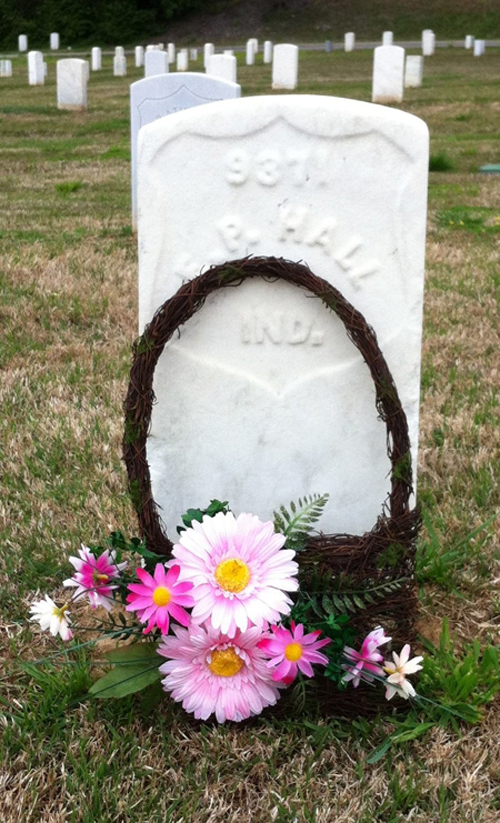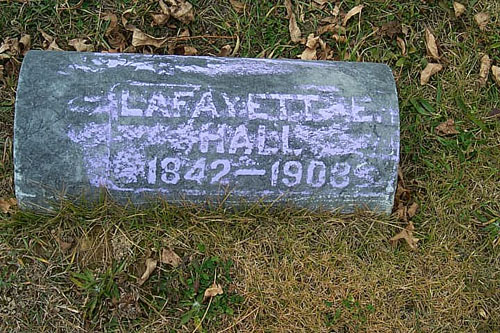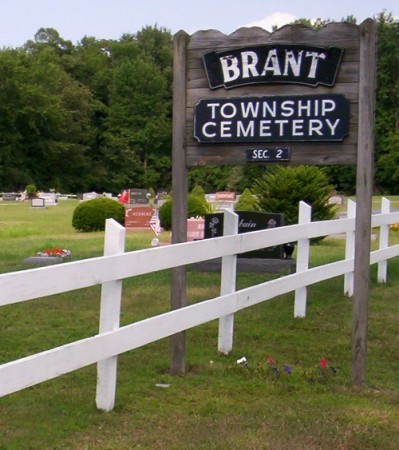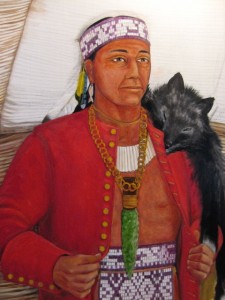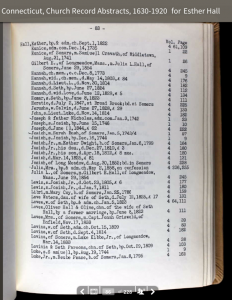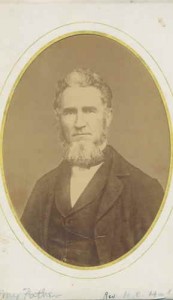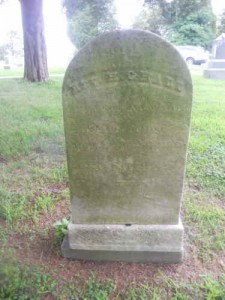Will of Lt. Luke Hall
By Kathryn Hall | May 27, 2019
Following is the last will and testament of Lt. Luke Hall of Somers, Tolland, Connecticut. He died September 19, 1826 at age 82. For further information about Lt. Luke Hall and his family, please visit post documenting their gravesites in Somers.
At a Court of Probate held at Ellington within & for the District of Ellington October 4th 1826
Present Asa Willey Esquire Judge
Horatio A. Hamilton & David Sheldon present this Will of Luke Hall, late of Somers in District deceased they being appointed Executers of Will and ……..of who trust …. Bonds according to Law and proved (?) the Will which was approved by Cout and ordered to be Recorded and kept on file
Asa Willey Judge
In the name of God Amen—I Luke Hall of Somers in Tolland County State of Connectical Although laboring at present under some indispositions of body yet being of sound and …posing mind memory and understanding though the mercy of God so make & ordain this my last Will and Testament in manner & form following First & principally I resign my soul with the utmost humility into the hands of Almighty God my creator humbly hoping for a blessed immortality through the merit and mediation of my blessed Saviour & Redeemer Jesus Christ & my body to the dust to be intered [sic]in a Christian burial form.
And as for such temporal estate as the Lord in his great Goodness & mercy has entreated me to the steward of—I give service & dispose thereof as follows
(?) I give & bequeath unto my four beloved grandchildren who are children of my Son Seth Hall [:] Seth Parsons, Levina, Sophronia & Homer all my share in a Lot of Seantick Meadow Land I own in common with my son Seth which is undivided [ ] being had to Calvin Pitkins deed to the [ ] & Seth & myself for a further description of said Lot—and I do further give and bequeath unto my afores four grandchildren Twelve Acres of plain land which was given me by my Hon. Father it bounds North and West on Obediah Kibbees Land—South on Hiram Pomeroys land & East on my own land all of the afores premises to be equally divided between the said four Grandchildren that is share & share alike to be theirs and their heirs forever—
Item I give & bequeath only my beloved daughter Mary Hall the dwelling house & other tenements now occupied by [ ] Eno together with the Lot of land there with connected bounding East & West on highways South on Samuel Peases Land containing about four acres to be hers & her heirs forever—And I do further give & bequeath unto my daughter Mary a piece or parcel of Land off the South part of my home farm as follows. Beginning on the West side of the road leading to Enfield in the North Iine of Samuel Peases land thence westwardly by Peases land & others to the southwest corner of my home farm thence North twenty five rods on the west line of my [ ] farm—thence eastwardly in a parallel line with the South line of [ ] farm until it comes in the same line with the fence running the West side of my orchard of Apple trees lying North of said line—thence North to & by the fence on the West side of said orchard to the middle point between the third & fourth row of Apples Trees from the South side thence Eastwardly between & near the center of third & fourth row of trees to the east side of [ ] Orchard to the stone wall—thence South by [ ] Stone wall or fence as it now stands until it comes to the distance of twenty five rods of the first mentioned line by Samuel Peases land—thence east in a parallel line with the Peases line afforementioned [sic] to [ ] highway & by said highway Southerly to the first mentioned corner to be hers & her heirs forever—
And further I do give & bequeath onto my [ ] Daughter Mary two acres of land off of the South part of my Seantick Meadow bound South on Joseph Roots land East on Seantick River West on a ditch near the bank of said meadow to be hers & her heirs forever.
And I do further give & bequeath unto my said daughter Mary one Cow & Six Sheep such of each as she may choose out of those that may remain at my decease—all of the above as foregoing property that I have given & bequeathed unto the said May is in payment for her services to me since she became of age in law to act for herself & do what I consider Justice required [ ] to her—And I do further give & bequeath unto my [ ] daughter Mary such articles of my household furniture as she may choose [,] not exceeding the total amount of the articles I gave to each of my older daughters Elizabeth & Martha after deducting what I have before this time
[ ] off & given to her & if she does not choose to take the whole amount as offered in my household furniture it is to be made up to her in my other property—And after my just debts are paid by my Executors.
Dear Visitor: This site has proven to be of great use to many researchers. It is the result of meticulous research over many years, employing the highest standards. I offer this freely and at my own expense. If you would like to help defray any of the costs of maintaining this site, please consider making a donation of any amount via the Donate button on the upper right of the site. Thank you so much. K. Hall
Topics: Connecticut | No Comments »
Flowers Placed on Grave of Erastus P. Hall
By Kathryn Hall | April 14, 2016
It with joy in my heart that I share that at last flowers have been placed on Erastus P. Hall’s grave in Nashville. His grave was kindly visited and decorated today, April 14, 2016, with these beautiful flowers by Reena Parkey King, the greatgreatgranddaughter of Diantha Samantha Hall, who was the sister of Erastus P. Hall. Thank you, Reena, for honoring his life in this way, which is so very much appreciated.
Topics: Civil War | No Comments »
Hall Hill Road
By Kathryn Hall | March 6, 2016

Somers, Connecticut
Hall Hill Road is named after the Halls of Bristol County who lived in Somers, CT. Somers Cemetery bears the graves of the many Halls who lived in Somers. The Halls married many people from the Parsons and Pease families.
(More to come…)
Topics: Connecticut | No Comments »
Death Certificate for Lafayett E. Hall
By Kathryn Hall | January 31, 2016
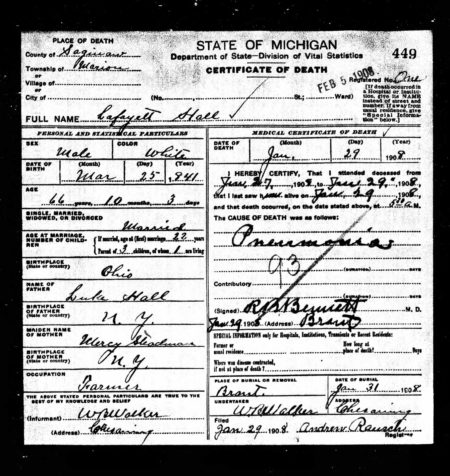
State of Michigan
County of Saginaw
Township of Marion
Lafayett Hall
Male, White
Date of birth: March 25, 1841
[Note discrepancy between headstone and death certificate. KH]
Age: 66 years, 10 months, 3 days
Married
First married at age 22
Three children, one living at time of death
Birthplace: Ohio
Father: Luke Hall
Birthplace of father: N.Y.
Mother: Mercy Steadman
Birthplace of mother: N.Y.
Occupation: Farmer
Date of death: Jan. 29, 1908
Cause of death: Pneumonia
Place of burial: Brant, Jan. 31, 1908
Lafayett E. Hall (b. March 25, 1842) is buried in Brant Township Cemetery in Saginaw Co., Michigan. Verification can be found in Saginaw County Cemeteries, Book Four, page 29, published by the Saginaw Genealogical Society, Inc. Lafayette’s grave can be found in Row 2, Section 2 in Cemetery #1, the oldest section of the cemetery. He is buried in Lot #219. It should be noted that this death certificate is one of the rare instances we have found a written record of his mother, Mercy Steadman, who has remained our brick wall for decades. The only other written trace we have found to date is on the death certificate of Diantha Hall Butler, Lafayett’s older sister. It should also be noted that for research purposes one should trace both Lafayett and Lafayette Hall. His name appears on his death certificate with an “e” at the end of his name, and what we now believe to be his Civil War registration (still being verified) his name also bears an “e” at the end of his name. Researchers should also be aware that his name will sometimes appear with the middle name “Marion”. It is not believed to be correct. His headstone marks his middle name as beginning with an “E”. Due to the fact Lafayett once lived in Marion County in Michigan it is highly likely that in old genealogy notes this county name appeared next to Lafayett’s name, and someone interpreted that to be his middle name. Without the benefit of computers such handwritten notes are sometimes misinterpreted by later generations. Longtime researchers who have poured over handwritten deeds and wills will appreciate what I am here saying. Thank you.
Brant Township Cemetery
Established in 1866 and located on section 21-16, on both sides of Brant Road, 1/4 mile east of Brant and Brennan Roads. The cemetery is about 7 1/2 acres in size and is owned by the township. The burial records are held by the township clerk.
Topics: Michigan | No Comments »
Inventory of the Estate of George Hall of Taunton–with notes
By Kathryn Hall | January 11, 2016
Having just read The Mayflower, Nathaniel Philbrick’s ambitious and brilliant rendering of the Plymouth community, I’m finding the histories of those ancestors more palpable, more approachable than ever before. One impulse, then, is leading to this additional post of the inventory of the estate of George Hall of Taunton, my Earliest Known Ancestor, this time with notes, for I found myself reading the inventory much more closely, realizing there were far too many items on the list about which I knew nothing. Some remain as originally listed, as their intention is obvious, but for the more obscure and lesser known items I’ve attempted to illuminate a more modern description. I believe this will shed a bit more light on what George and his family found of value, thus illuminating their lives in the 1600’s. Remarkable, no? If anyone has further knowledge of the articles on this list, your comments will be welcomed. My notes are in brackets. Thank you. KH
Inventory of the Estate of George Hall of Taunton
A true Inventory of the estate of Gorge hall of Taunton in the Iurisdiction of Plymouth in New England; (yeoman) deceased october 30th 1669 and exhibited to the Court held att Plymouth aforsaid the first of March anno: domine 1669 on the oathes Mistris Mary hall Widdow
Impr: his wearing apparrell woolen and Linnine [linen] 05 00 00
Item a bedsted and bed and furiture therto appertaining 10 00 00
Item a white Couerlid [coverlet] 002 10 00
Item a bed 3 bolsters a Rubg and 2 blanketts 03 00 00
Item sheets table Linnine with other Linnine [linen table cloths, called to this day “linens”] 03 00 00
Item new homade cloth 6 yards 001 04 GO
Item 1 Chest 001 00 00
Item bookes and papers 001 02 00
Item lether [leather] 001 12 00
Item 2 trunckes and 3 boxes 000 09 00
Item 2 old trapps 000 05 00
Item nailes 000 15 00
Item powder and lead 000 06 06
Item lockes and snite bills [The only reference I can find to “snite bills” is to hedgehogs. I’m certain the reference here is to some kind of apparatus used in building or common work, probably made of metal.] 000 05 00
Item Ioyrners tooles [joiners tools] 002 05 00
Here is an old joiners tool box found in the UK. We don’t know if George had such a box, but this portion of the inventory is describing his carpenter’s tools as would be found in such a box.
Item more tooles 002 06 06
Item old Iron 000 05 00
Item sawes & more tooles and Iron barrs 001 06 00
Item a sledge a paire of fetters & forkes 000 07 00
[Fetters are leg irons or shackles. I found one reference to “fetters and forkes” used in Africa, but no further information. One must assume fetters and forkes were used to restrain someone.]
Item Cordage flax [flax rope] and gertwebb 000 14 00
Item woole 000 06 00
Item hndJrons [andiron: one of a pair of metal stands, usually of iron or brass, for holding logs in a fireplace.] spitt peele [A “spit” is a long, thin metal rod pushed through meat in order to hold and turn it while it is roasted over an open fire. A peel is a flat shovel used to place bread into an oven or to remove same.] and other Instruments 002 00 00
Item hookes and hinges 000 03 00
Item a pillian [pillion: a cushion attached to the back of a saddle for an additional passenger] 000 10 00
Item Indian Corne 14 bushells 002 14 00
Item brasse pannes 002 00 00
Item 2 brasse potts & brasse posnetts and skillitts [skillets] 001 04 00
Item 1 Iron pott 1 spice Mortor and pestell [mortar and pestle] 001 04 00
Item a warming pan a frying pan a skillett 2 paire of pot hookes and a treiuett 000 12 00
Item 2 brasse kettles 001 00 00
Item pewter dishes spoones a skimer and tin vessells 001 03 00
Item 1 siluer spoone 000 04 00
Item serchees seiues and boxes a smale barrell and a keading trough 000 15 00
Item 2 barrells of Cyder 001 04 00
Item empty Caske 000 18 00
Item parte of a barrell of beife [beef] 000 12 00
Item Tubbs and pailes and other lumber 000 16 00
Item & spining wheele a paire of bellowes a winowing sheet [a piece of cloth set up under the winnowing basket or machine to catch seeds as the grain is winnowed] 3 seiues & other old lumber 001 00 00
Item 3 Cowes 10 10 00
Item a mare 05 00 00
Item 6 swine 05 00 00
Item a yoake of steers 07 00 00
Item a yearling 01 00 00
Item a yeake of oxen 10 00 00
Item plow Chaines a doubble share 3 shares and Coulters & 2 sett of harrow teeth [piece of equipment that uses many flexible iron teeth mounted in rows to loosen the soil before planting] 03 13 00
Item 5 hundred of Iron 05 10 00
Item boxes hoopes and other Iron pertaining to a Cart 00 18 00
Item a Cart Rope 000 07 00
Item Creditt 013 12 06
Item a share in the Iron workes 030 00 00
Item a Cyder presse [cider press] 02 00 00
Here is an old cider press. Perhaps it approximates what George and Mary had to work with.
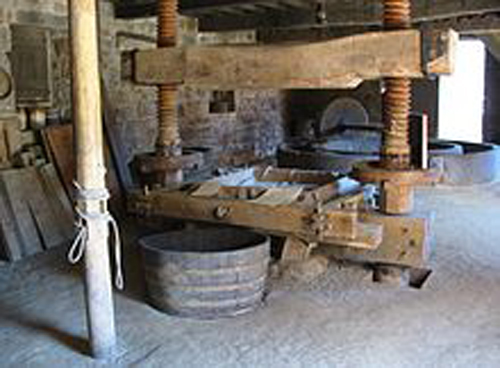
———–
suma totalis 170 15 00
———–
February 8th: 69/70
Aprised by
Richard Williams
Walter deane
Plymouth Colony Wills, vol. III, p. 17
George Hall
Topics: Massachusetts | No Comments »
The Inventory of George Hall of Taunton
By Kathryn Hall | January 5, 2016
Following is the official inventory of George Hall of Taunton, from Plymouth Colony Wills, apprised by Richard Williams and Walter Deane, siting “Mistris Mary hall Widdow” [sic].
February 8, 1669/1670
Plymouth Colony Wills 3:17
#P176
The Inventory of George Hall
A true Inventory of the estate of Gorge hall of Taunton in the Iurisdiction of Plymouth in New England; (yeoman) deceased october 30th 1669 and exhibited to the Court held att Plymouth aforsaid the first of March anno: domine 1669 on the oathesMistris Mary hall Widdow Impr: his wearing apparrell woolen and Linnine 05 00 00
Item a bedsted and bed and furiture therto appertaining 10 00 00
Item a white Couerlid 002 10 00
Item a bed 3 bolsters a Rubg and 2 blanketts 03 00 00
Item sheets table Linnine with other Linnine 03 00 00
Item new homade cloth 6 yards 001 04 GO
Item 1 Chest 001 00 00
Item bookes and papers 001 02 00
Item lether 001 12 00
Item 2 trunckes and 3 boxes 000 09 00
Item 2 old trapps 000 05 00
Item nailes 000 15 00
Item powder and lead 000 06 06
Item lockes and snite bills 000 05 00
Item Ioyrners tooles 002 05 00
Item more tooles 002 06 06
Item old Iron 000 05 00
Item sawes & more tooles and Iron barrs 001 06 00
Item a sledge a paire of fetters & forkes 000 07 00
Item Cordage flax and gertwebb 000 14 00
Item woole 000 06 00
Item hndJrons spitt peele and other Instruments 002 00 00
Item hookes and hinges 000 03 00
Item a pillian 000 10 00
Item Indian Corne 14 bushells 002 14 00
Item brasse pannes 002 00 00
Item 2 brasse potts & brasse posnetts and skillitts 001 04 00
Item 1 Iron pott 1 spice Mortor and pestell 001 04 00
Item a warming pan a frying pan a skillett 2 paire of pot hookes and a treiuett 000 12 00
Item 2 brasse kettles 001 00 00
Item pewter dishes spoones a skimer and tin vessells 001 03 00
Item 1 siluer spoone 000 04 00
Item serchees seiues and boxes a smale barrell and a keading trough 000 15 00
Item 2 barrells of Cyder 001 04 00
Item empty Caske 000 18 00
Item parte of a barrell of beife 000 12 00
Item Tubbs and pailes and other lumber 000 16 00
Item & spining wheele a paire of bellowes a winowing sheet 3 seiues & other old lumber 001 00 00
Item 3 Cowes 10 10 00
Item a mare 05 00 00
Item 6 swine 05 00 00
Item a yoake of steers 07 00 00
Item a yearling 01 00 00
Item a yeake of oxen 10 00 00
Item plow Chaines a doubble share 3 shares and Coulters & 2 sett of harrow teeth 03 13 00
Item 5 hundred of Iron 05 10 00
Item boxes hoopes and other Iron pertaining to a Cart 00 18 00
Item a Cart Rope 000 07 00
Item Creditt 013 12 06
Item a share in the Iron workes 030 00 00
Item a Cyder presse 02 00 00
———–
suma totalis 170 15 00
———–
February 8th: 69/70
Aprised by
Richard Williams
Walter deane
Plymouth Colony Wills, vol. III, p. 17
George Hall
Topics: Massachusetts | No Comments »
Book Corner: Mayflower by Nathaniel Philbrick
By Kathryn Hall | January 1, 2016
Christmas brought an unexpected gift from one of the treasured distant cousins–a copy of Mayflower by the brilliant writer and historian Nathaniel Philbrick. It’s an absolute treasure of a book particularly for anyone with Puritan roots. As I read it I underscored each reference to Taunton and any other clues I thought might shed some light on George Hall and his family in Taunton in the 1630’s up through the end of the 1660’s. Some of you will be familiar that George died in 1669 in Taunton. We also know that George was a large landowner in Taunton. Though I had often wondered about the Native Americans who lived among the Puritans, the only story I’d ever actually run across was the story of Ebenezer Hall and his unfortunate demise in Mantinicus Island. But imagine my delight and surprise, when I at last finished Philbrick’s Mayflower and began to review my own extensive research of George Hall set against my new knowledge of that particular Puritan era. There in the published excerpt from Richard Brainard Hall’s Halls of New England was this passage!
George Hall and his wife Mary [Family i), were the ancestors of the Halls of Taunton. They emigrated, it is said, from Devonshire County, England, in 1636-7. George Hall is recorded as proprietor of land in Duxbury, Mass., in 1637, about the date of his settlement in ” Cohannet,” — Taunton ; he was one of the forty-six original proprietors of the first territorial ” purchase ” of the Indian Sachem Massasoit, including a tract of eight miles, (an oblong, square, being the present territory of Taunton, Berkley, Raynham, extending to Mansfield) ; he had a twelve acre share, in connection with Richard Williams, John and Walter Dean and others, who had similar shares, spanning Taunton river, on the banks of which they erected their first humble dwellings and were neighbors and friends for lifetime.
I’d just spent the last week reading about the Native American leader (or “sachem”), Massasoit, and, he did, indeed, sell land to the Puritans. He also entered an agreement with the folks at Plymouth that helped ensure a peaceful and supportive beginning. But that is just the beginning of the story. And here is his picture, which I love.
“Vivid and remarkably fresh…Philbrick has recast the Pilgrims for our age.” ~The New York Times Book Review
If your soul dictates that you dig into your own ancestral roots I highly recommend that you read Mayflower. Don’t let any voice in your head say, “But I had no ancestors on the Mayflower”. Again, Philbrick only begins with the ship’s (amazing and harrowing) journey. You may find that the book unsettles what we were taught in school, but this book is extremely well researched and was nominated for the Pulitzer Prize. Without a doubt Philbrick is a true scholar and master storyteller. I could hardly put the book down, and that’s saying a lot of a history book full of hardship and battle, don’t you think?
Leave comments after you read, will you? And let us know if you find your ancestors among its pages.
Thank you.
KH
Topics: Book Corner | No Comments »
Abstract from Connecticut Church Records 1630-1920 LUKE HALL/RUBY PEASE HALL
By Kathryn Hall | September 6, 2015
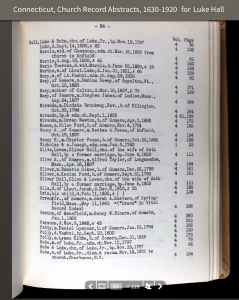
[Visitors can click on images to enlarge.]
Early Connecticut settlers established the Congregational Church as the tax-supported state church until 1818 when the state constitution was accepted, abolishing the connection between church and state. Pictured is an abstract from Connecticut church records 1630-1920 that documents the following:
Rube [Ruby], w. of Luke, Jr., adm.ch. Nov. 12, 1797
Luke (b. 6 July 1795) and Rube [Ruby] (b. 14 July 1797), children of Luke, Jr., baptized November 19, 1797
This verifies that the first two children born of Luke Hall, Jr. and Ruby (Pease) Hall were born and baptized in Somers, Tolland, Connecticut, prior to Luke, Jr. and Ruby (Pease) Hall’s move to Smyrna, Chenango, New York, where the remainder of their children were born.
We also note:
Rube [Ruby], w. of Luke, Jr., dism. and recom. Nov. 14, 1802 to church, Sherburne, N.Y.
Therefore we know that Luke Hall, Jr. and his wife Ruby (Pease) Hall arrived in Smyrna before November 1802.
Additionally:
Luke, d. Sept. 14, 1826, A. 82
This is the church record of the death of Luke, Jr.’s father.
In this second abstract of Connecticut church records we find:
Luke Jr., m. Reube [Ruby] Pease, b.of Somers,Jan. 8, 1795
And:
Luke, s. Sam (ue)l [Samuel], bp. Aug.19, 1744
And lastly:
John, s. Lieut.Luke, d. Nov.14, 1814
Footnote: Abbreviations include:
adm.ch.=admitted to church
bp.=baptisms
dism. & recom.=dismissed and recommended
Topics: Connecticut | No Comments »
Reverend Hezekiah Cooley Hall
By Kathryn Hall | September 6, 2015
Hezekiah Cooley Hall was the son of Luke Hall, Jr. and Ruby (née Pease) Hall. He was born 9 May 1810 in Smyrna, Chenango, New York, two years after the birth of his brother Daniel Spencer Hall (b. February 1808). His surviving siblings at the time were Luke Hall [III], Ruby Hall, Fanny Hall, and Flora Hall. Hezekiah married Lydia Almira York 5 November 1852 in Brookfield, Madison Co., New York. He died 16 February 1872. They had three children. He is buried in Cedar Green Cemetery in Clayton, Gloucester, New Jersey. The back of his gravestone reads Rev. H.C. Hall.
Hezekiah’s wife, Lydia Almira (York) Hall, b. 29 March 1822, was the daughter of Ichabod and Freelove (Gardner) York. Lydia graduated from Cazenovia Seminary in 1848 and was a teacher at Brookfield Academy. She was Preceptress of Onondaga Academy at Manlius, New York and Preceptress at Silver Creek Academy, Silver Creek, New York and later Superintendent of the Mission Schools among the Onondaga Indians of the Onondaga Reservation. Lydia died 26 September 1892.
From Hezekiah’s obit:
Birth: May 9, 1810
New York, USA
Death: Feb. 16, 1872
Clayton
Gloucester County
New Jersey, USA
Rev. Hezekiah C. Hall was the son of Luke and Ruby (Pease) Hall. He was the husband of Lydia Almira (York) Hall. He was a minister in the Oneida Conference and Central New York Conference of the Methodist Episcopal Church. [See notes below. KH] He served in the ministry for 28 years.
Obituary
Northern Christian Advocate
March 14, 1872
HALL.–Hezekiah C. Hall of the Central New York Conference, died in New Jersey, February 16th, 1872.
Bro. Hall was born in Smyrna, New York in 181O. At the age of twenty-four he gave his heart to God and joined the Methodist Episcopal Church. His love to God and souls was such, and feeling called to the ministry, he joined the Oneida Conference in 1844, and was stationed at East Homer. After nine years of labor, his health was such that he took a superannuated relation for four years. His health improving he took a charge, and was in the effective ranks for nine years more. His last charge was at DeRuyter and Sheds Corners. After laboring here for about six months his health entirely failed. His sufferings were severe for months when he recovered so as to be about the house. He had been afflicted with sciatic rheumatism for years, which at times caused intense pain, but such was his love for the work, and his ambition to do what he could, that on one charge he was obliged for weeks to go on his crutches to the church, and then sit down to preach. About five years ago, hoping a change of climate might help him, he removed with his family to New Jersey, a few miles north of Vineland. But he only partially recovered, and to add to his sufferings he was thrown from a wagon, dislocating his hip, which not being properly set, caused him increased pain. When I visited him last fall, I found him able to walk about some, but only the wreck of his once strong and manly form. But his faith in God was strong, and he was looking for the time when his sufferings would end, and he be at rest. He retained his reason till the last, and died in the full hope of a blissful immortality. “Our people die well,” and the Gospel which he preached, now sustained him. His funeral was attended at the Methodist Episcopal Church in Clayton, and he was buried there. He leaves a wife who for nearly twenty years has shared with him the joys and trials of life, and three children.Written by Rev. William E. York
Tully, March 2nd, 1872
History of Cazenovia College [Oneida Conference Seminary]
Cazenovia College traces its birth to 1824, when it was founded as the Seminary of the Genesee Conference, the second Methodist seminary to be established in the United States. It opened in what had been the Madison County Courthouse.
Although sponsored by the Methodists, the seminary was nonsectarian, and its trustees were a mixture of clergy and laymen. Financial support came not only from church members but also from forward-thinking local residents who recognized the seminary’s beneficial effect on employment, the general economy and the cultural life of the village. The community’s continuing interest in the seminary and the College cannot be overestimated.
The seminary was a pioneer in coeducation. From the beginning it welcomed both men and women who wanted to prepare for college or complete their education in Cazenovia. In two years there were 145 students.
Rooms in the residential facilities were 11 feet square and cost students $1 per week. The buildings housed both men and women, but strong doors divided the two areas.
Distinguished alumni include Jesse Truesdell Peck, a founder and first president of the board of trustees at Syracuse University; Charles Dudley Warner, editor of the Hartford Courant and close friend of Mark Twain; and Leland Stanford, who founded and endowed Stanford University of California, served as a United States senator and governor of California, and was president of the Central Pacific Railroad. When America’s first transcontinental railroad was completed, it was Stanford who drove the golden spike where the two rail sections joined in Utah.
Over the years the seminary changed its name several times, first to the Seminary of the Genesee and Oneida Conferences, later to the Oneida Conference Seminary, then to the Central New York Conference Seminary. In 1894 it became Cazenovia Seminary. Between 1904 and 1931 the institution also functioned as a secondary school for young people from the township, an arrangement that ended when Cazenovia Central High School was built.
Topics: New York | No Comments »
Reverend John Judson Steadman
By Kathryn Hall | February 12, 2014
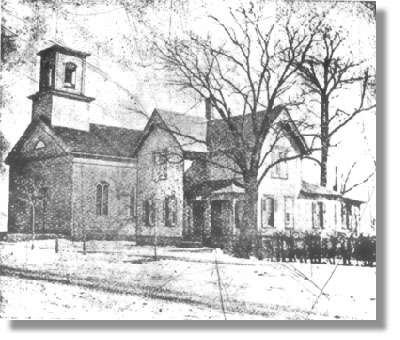
Original Methodist church at Newton Falls, Ohio
To the left is a photo of the original parish building of the Methodist Episcopal Church where Reverend J. J. Steadman once served as minister.
The following is an excerpt from History of Erie Conference by Jason Nelson Fradenburgh:
In 1831 John J. Steadman was appointed third preacher of the Euclid and Cleveland Circuit. He was a native of Cattaraugus County, NY; his parents died when he was quite young, and the bereaved family moved to Charlestown, Portage County, Ohio, where young Steadman was converted under the labors of B.O. Plimpton in 1824-25. He immediately gave himself wholly to the Lord and zealously engaged in this service. He thirsted for knowledge and found time to study at the home of A.C. Gardner, Esq. of Parkman, Ohio.
How is John Judson Steadman important to the Hall family history? It is because Luke Hall, married to Mercy Steadman, lived in Charlestown, Portage County, Ohio at this time, and Luke and Mercy were very active in founding and establishing this very church. Also part of this church were Dennis Steadman, and his wife, Matilda Worden Steadman, a Worden from South Kingston, Washington, Rhode Island.
“Matilda Worden, b 27 March 1799, in South Kingston [Washington, RI]; was among the first operatives in the pioneer cotton mill of Gov. Oliver Wolcott, in Litchfield Co., Ct; m (1st) 2 Dec 1819, Dennis Stedman, in Tolland, Mass.; moved to Charlestown, O., 1820, where he d 16 March 1846, aged 50 years; she m (2d) in 1849, Amasa Canfield, b in Ct. in 1786; she died in Ravenna, 28 Sept. ’59, aged 60 1/2 yeaers; Mr. Canfield d Jan. 1863, aged 77 years.”
from Family of John and Jane Worden, p. 86
Much more will be written of them in following posts. Meanwhile, please see previous post on the History of Erie Conference, and this family as it is involved with Reverend John J. Steadman’s church.
Topics: Ohio | No Comments »
« Previous Entries


